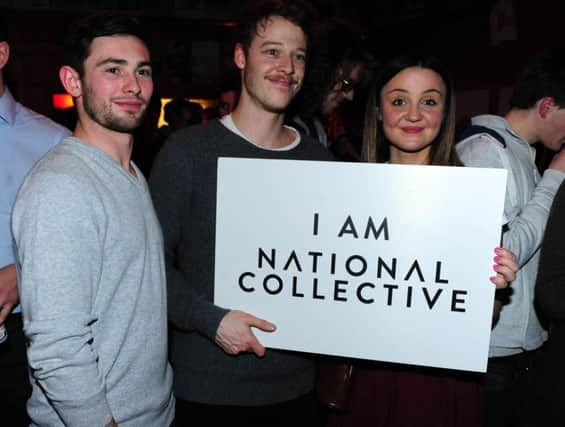Alex Massie: Where’s the art, National Collective?


They, like Women for Independence and Business for Scotland, were one of the more prominent “independent” organisations campaigning for Scottish independence.
National Collective were a useful, perhaps even necessary, part of the referendum campaign. Not because they proved terribly effective but because they helped substantiate the claim that there was much more to the independence movement than just the SNP – on the contrary, Yes Scotland was a broad coalition. There was something to this, but it was also a polite fiction. The SNP, quite reasonably, were always the main show in town.
Advertisement
Hide AdAdvertisement
Hide AdStill, the youngsters – they were mostly young – at National Collective fulfilled a role. They were an energetic presence during the campaign even if they spent an inordinate amount of time congratulating themselves and rather less listening to, far less persuading, people who were not already keen supporters of independence.
What happens next, however? Well, Ross Colquhoun, director of National Collective, has since been hired by the SNP as an “engagement strategist”. Cue rumblings of discontent from some of National Collective’s erstwhile supporters. Foremost among them is the rapper Loki, who has accused National Collective of “getting into bed with the government and the establishment”. The SNP, he observes, “are the biggest public relations organisation in the country”.
This has the considerable merit of being true. However, with only a few notable exceptions, one feature of the independence movement has been the manner in which it has declined to offer any criticism of the SNP, or any analysis of its own shortcomings. If that means swallowing a measure of pride, then so be it; the cause is more important than any immediate or short-term differences.
But it’s also, you might think, a problem for citizens with artistic pretensions. In the contest between art and politics it was always clear – and remains clear now – that for many activists, politics trumps art. Then again, National Collective’s artistic credentials have never been entirely clear.
On the eve of the referendum they claimed to have signed up 1,300 “artists” who put their names to a letter supporting independence. But since these included folk styled as “fashion blogger”, “organiser and creative”, “English teacher” and “comedian” it’s clear National Collective’s definition of “artist” was so broad as to be almost meaningless.
Perhaps this was just as well. The movement has produced no art of any consequence, after all. There was plenty of activity but precious little culture. Typical of National Collective’s Yoko Ono-inspired “Hello Sky! Hello Sunshine!” approach was their desire that “All Yes Scotland events should include a ‘wish tree’” comprised of scraps of paper upon which citizens had written “what they wanted to see in an independent Scotland”. Whatever this may be, it’s not art.
Nor was this atypical. National Collective was keen on promoting selfies in which citizens posed with placards proclaiming “I am National Collective” as though this declaration of group identity – and groupthink – mattered or could be considered daring. This was as subversive as a flat white in Finnieston and lends credence to Loki’s complaint that National Collective was “a middle-class clique” far too fond of “esoteric academic theory” and “Guardian-lite” posturing.
In fairness, there was some atrocious poetry too. (A typical independence poem ran: September’s dawn will come and we will say,/”They brought us bogles and the shards of shame,/the lies of alien greed and now with hollow/minds of empires lost, they have to yield our day.”)
Advertisement
Hide AdAdvertisement
Hide AdStill, according to Fiona Hyslop, the culture minister, National Collective “changed Scotland” – though, again, the manner in which this “change” can be seen or substantiated remains puzzlingly elusive. Perhaps that’s because so much of what it writes seems better-suited to the mangled prose required by government funding applications than anything anyone might actually want to read.
According to National Collective’s Robin Weaver, “the [referendum] campaign has provided Scots with a collective identity shaping experience”. Not only that but “political involvement” is “integral to identity”, an observation that, like so much else you’ll find at National Collective sounds momentarily impressive until such point as you realise it’s guff.
Nevertheless, “Scotland may have voted against establishing its own country, but it did proclaim its animated and multi-faceted identity”. This, it must be said, is an interesting claim, not least since it suggests Scotland cannot be fully Scotland unless it is an independent state. More importantly, and for all the movement’s oft-proclaimed “inclusiveness”, this “multi-faceted identity” turns out to be surprisingly one-dimensional. If you’re not Yes, you’re nobody. Scotland is smaller than you think and there’s less room for dissent than often imagined.
And that’s the real problem with National Collective. For all the wishing trees and student union agitprop, and for all the concerns about the organisation’s supposed lack of “transparency”, “accountability” and “democracy”, their greatest shortcoming was their lack of actual art. In the end it turned out the hipster unco guid had nothing to say.
FOLLOW US
SCOTSMAN TABLET AND MOBILE APPS